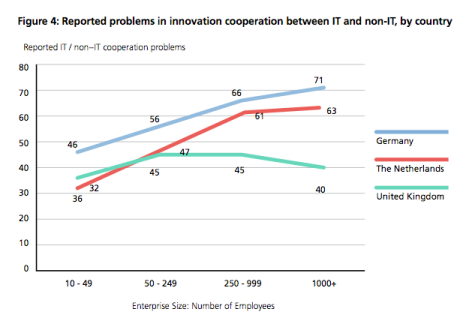CIOs: Coach and Communicate with C-suite for Digital Innovation
This is one of our free-to-access content pieces. To gain access to all Ideas for Leaders content please Log In Here or if you are not already a Subscriber then Subscribe Here.

European companies are losing innovation opportunities because C-suite executives fail to respond to information technology and digital-related proposals of the CIO and the information technology function of the company, according to a new survey of European companies in three countries. The problem: lack of communication between IT and non-IT leaders.
The digital age creates a wide range of new opportunities for innovation. Examples include new marketing outlets through social media; ‘big data’ information on customers and the market; mobile devices that connect companies to customers 24/7; and apps that redefine business models. However, not all C-suite executives have a digital mindset. As a result, innovation proposals from CIOs and IT functions can run into roadblocks at the C-suite level of their companies.
The challenge of implementing digital innovation ideas was highlighted in a recent survey of 900 UK, German and Dutch CIOs. Nearly 25% of the 900 CIOs surveyed said their companies were losing opportunities for innovation because their C-suite colleagues were not responding in a timely manner to digital- or IT-related proposals, or failed to dedicate the necessary resources to support the innovation.
The problem, according to the CIOs surveyed, is that only about half of the companies in the survey had non-IT executives with a level of IT understanding that is sufficient to identify digital innovation opportunities in their markets. Less than half of the companies had unanimous support for IT innovation from the C-suite.
For 35% of the companies in the survey, all IT-related innovation opportunities originated from the IT function — the problem again being that non-IT executives did not have sufficient knowledge about the digital space in their markets to make a contribution.
The challenge is clear: CIOs must become ‘e-leaders’; that is, they must take responsibility for educating their non-IT colleagues in the C-suite, helping them understand the potential business impact of digital innovation. This is not easy, however, because in nearly half of the companies, communication between IT and non-IT is seriously impaired.
The survey results revealed two factors related to problematic communication between IT and non-IT colleagues. The first factor is size. In small companies, those with less than 30 employees, the lines of communication between the IT function and the rest of the organization are much more open — even across disciplines that have different jargon. In larger organizations, it’s a different story. Twice as many CIOs from companies with between 500 and 1,000 employees reported communication problems, compared to CIOs from the smallest companies. Once above the threshold of 1,000 employees, however, the communication problems seem to be reduced. Thus, it seems that on a whole e-leadership is an especially acute problem for mid-sized companies.
These are the overall survey results. When the data is parsed according to country, however, surprising differences appear. The correlation between size and miscommunication between IT and non-IT is linear in Germany; that is, the larger the organization, the more communication problems occur. In the Netherlands, the problems increase with the size of the organization up to 1,000 employees, and then level off. In the United Kingdom, the problems of miscommunication start levelling off at 50-250 employees, and communication actually improves above 1,000 employees.
Thus, larger companies in the UK and the Netherlands seemed to have resolved the issues, while in large German companies, the miscommunication continues.

Whatever the size of the organization, CIOs who see their companies losing opportunities in digital innovation must act to break down the communication barriers between IT and non-IT executives. Here are some suggestions:
Too many companies are missing opportunities because of the wall between IT and non-IT areas of the business; it is the CIO who can take the leadership role in breaking down those walls.

Ideas for Leaders is a free-to-access site. If you enjoy our content and find it valuable, please consider subscribing to our Developing Leaders Quarterly publication, this presents academic, business and consultant perspectives on leadership issues in a beautifully produced, small volume delivered to your desk four times a year.

For the less than the price of a coffee a week you can read over 650 summaries of research that cost universities over $1 billion to produce.
Use our Ideas to:
Speak to us on how else you can leverage this content to benefit your organization. info@ideasforleaders.com